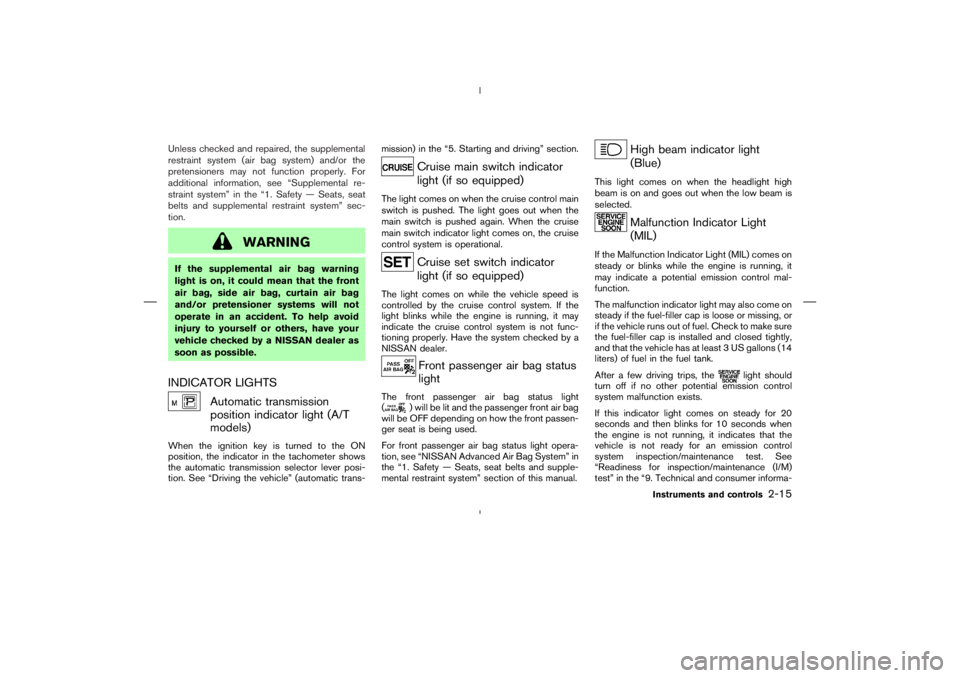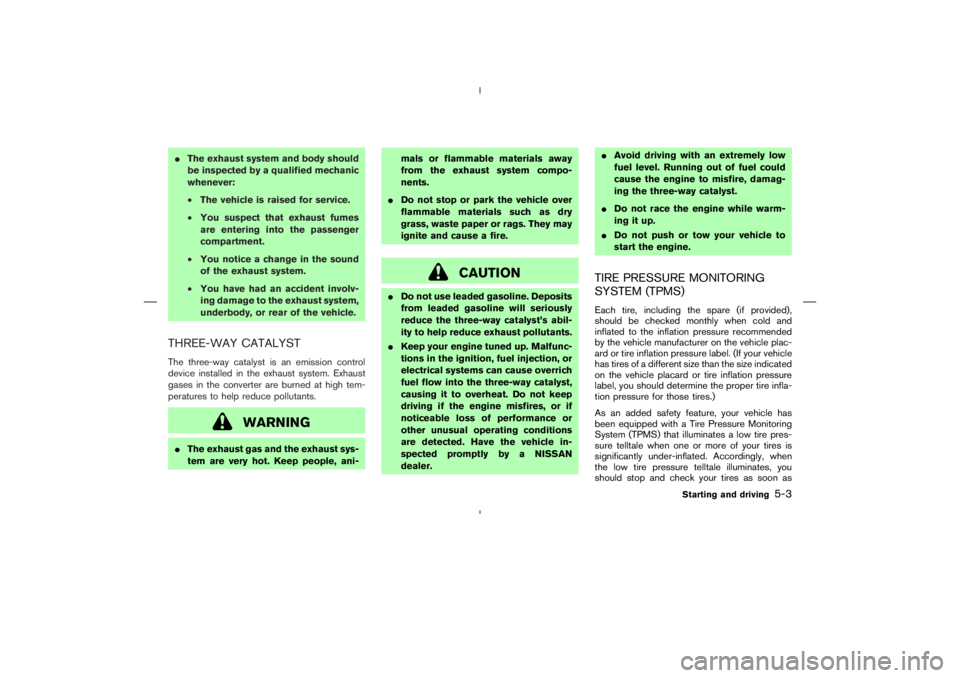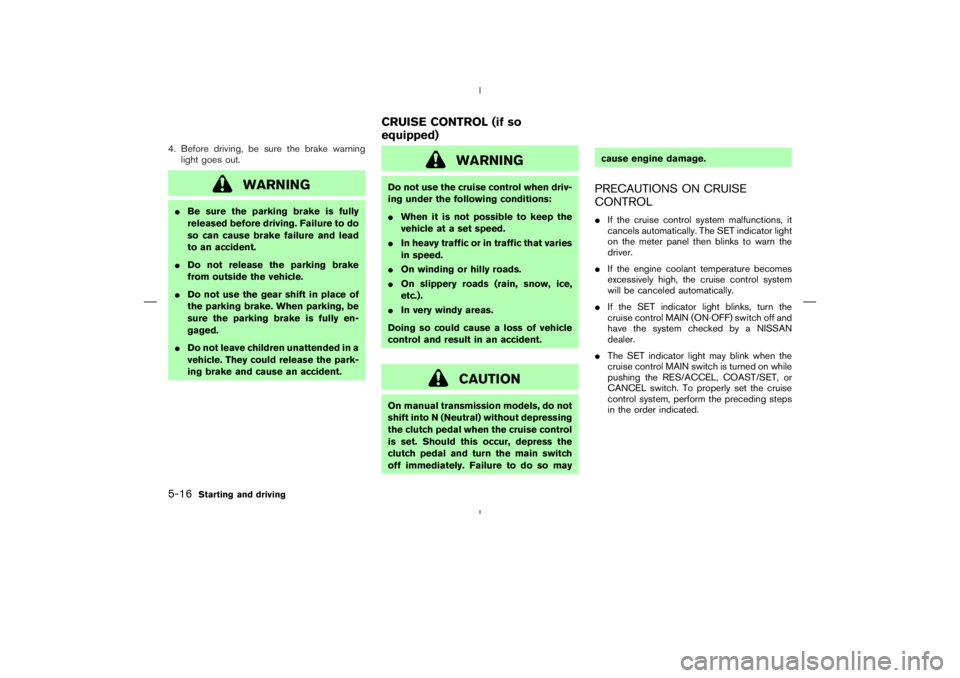Page 74 of 313

Anti-lock Braking System
(ABS) warning light
Low washer fluid warning light
High beam indicator light (Blue)
Automatic transmission check warning
light (A/T models)
Seat belt warning light
Malfunction Indicator Light (MIL)
or
Brake warning light
Supplemental air bag warning light
Slip indicator light
Charge warning light
Automatic transmission position indicator
light (A/T models)
Traction Control System (TCS) off indica-
tor light (if so equipped)
Door open warning light
Cruise main switch indicator light
(if so equipped)
Vehicle Dynamic Control (VDC) off indi-
cator light (if so equipped)
Engine oil pressure warning light
Cruise set switch indicator light
(if so equipped)
Soft top indicator light (Roadster models)
Low tire pressure warning light
Front passenger air bag status light
Turn signal/hazard indicator lights
CHECKING BULBSApply the parking brake and turn the ignition key
to ON without starting the engine. The following
lights will come on:
,
or
,
,
The following lights come on briefly and then go
off:
,
or
,
,
,
,
,
If any light fails to come on, it may indicate a
burned-out bulb or an open circuit in the elec-trical system. Have the system repaired
promptly.
WARNING LIGHTS
or
Anti-lock Braking
System (ABS)
warning light
When the ignition switch is in the ON position,
the Anti-lock Braking System (ABS) warning
light illuminates and then turns off. This indicates
the ABS is operational.If the ABS warning light illuminates while the
engine is running, or while driving, it may indicate
the ABS is not functioning properly. Have the
system checked by a NISSAN dealer.
If an ABS malfunction occurs, the anti-lock
function is turned off. The brake system then
operates normally, but without anti-lock assis-
tance. See “Brake system” in the “5. Starting
and driving” section.
WARNING/INDICATOR LIGHTS
AND AUDIBLE REMINDERS
Instruments and controls
2-11
Page 75 of 313
or
Brake warning light
This light functions for both the parking brake
and the foot brake systems.
Parking brake indicator:
When the ignition switch is in the ON position,
the light comes on when the parking brake is
applied.
Low brake fluid warning light:
The light warns of a low brake fluid level. If the
light comes on while the engine is running with
the parking brake not applied, stop the vehicle
and perform the following:
1. Check the brake fluid level. Add brake fluid as
necessary. See “Brake and clutch fluid” in the
“8. Maintenance and do-it-yourself” section.
Charge warning light
If the light comes on while the engine is running,
it may indicate that the charging system is not
functioning properly. Turn the engine off and
check the alternator belt. If the belt is loose,
broken, missing or if the light remains on, see a
NISSAN dealer immediately.
Page 78 of 313

Automatic transmission
position indicator light (A/T
models)
When the ignition key is turned to the ON
position, the indicator in the tachometer shows
the automatic transmission selector lever posi-
tion. See “Driving the vehicle” (automatic trans-mission) in the “5. Starting and driving” section.
Cruise main switch indicator
light (if so equipped)
The light comes on when the cruise control main
switch is pushed. The light goes out when the
main switch is pushed again. When the cruise
main switch indicator light comes on, the cruise
control system is operational.
Cruise set switch indicator
light (if so equipped)
The light comes on while the vehicle speed is
controlled by the cruise control system. If the
light blinks while the engine is running, it may
indicate the cruise control system is not func-
tioning properly. Have the system checked by a
NISSAN dealer.
Front passenger air bag status
light
The front passenger air bag status light
(
) will be lit and the passenger front air bag
will be OFF depending on how the front passen-
ger seat is being used.
For front passenger air bag status light opera-
tion, see “NISSAN Advanced Air Bag System” in
the “1. Safety — Seats, seat belts and supple-
mental restraint system” section of this manual.
High beam indicator light
(Blue)
This light comes on when the headlight high
beam is on and goes out when the low beam is
selected.
Malfunction Indicator Light
(MIL)
If the Malfunction Indicator Light (MIL) comes on
steady or blinks while the engine is running, it
may indicate a potential emission control mal-
function.
The malfunction indicator light may also come on
steady if the fuel-filler cap is loose or missing, or
if the vehicle runs out of fuel. Check to make sure
the fuel-filler cap is installed and closed tightly,
and that the vehicle has at least 3 US gallons (14
liters) of fuel in the fuel tank.
After a few driving trips, the
light should
turn off if no other potential emission control
system malfunction exists.
If this indicator light comes on steady for 20
seconds and then blinks for 10 seconds when
the engine is not running, it indicates that the
vehicle is not ready for an emission control
system inspection/maintenance test. See
“Readiness for inspection/maintenance (I/M)
test” in the “9. Technical and consumer informa-
Instruments and controls
2-15
Page 82 of 313
button on the keyfob.
The alarm is activated by:
�Opening the door without using the key or
keyfob.
�Opening the rear hatch or the trunk lid with-
out using the keyfob.
How to stop an activated alarmThe alarm will stop only by unlocking a door with
the key, or by pushing the UNLOCK
but-
ton on keyfob. The alarm will not stop if the
ignition key is turned to ACC or ON.
If the system does not operate as de-
scribed above, have it checked by a
NISSAN dealer.
NISSAN VEHICLE IMMOBILIZER
SYSTEMThe NISSAN Vehicle Immobilizer System will not
allow the engine to start without the use of the
registered key.
If the engine fails to start using the registered key
(for example, when interference is caused by
another registered key, an automated toll road
device or automated payment device on the key
ring), restart the engine using the following
procedures:
SIC1699A
Instruments and controls
2-19
Page 188 of 313

CAUTION
�Do not use leaded gasoline. Deposits
from leaded gasoline will seriously
reduce the three-way catalyst’s abil-
ity to help reduce exhaust pollutants.
�Keep your engine tuned up. Malfunc-
tions in the ignition, fuel injection, or
electrical systems can cause overrich
fuel flow into the three-way catalyst,
causing it to overheat. Do not keep
driving if the engine misfires, or if
noticeable loss of performance or
other unusual operating conditions
are detected. Have the vehicle in-
spected promptly by a NISSAN
dealer.�Avoid driving with an extremely low
fuel level. Running out of fuel could
cause the engine to misfire, damag-
ing the three-way catalyst.
�Do not race the engine while warm-
ing it up.
�Do not push or tow your vehicle to
start the engine.
TIRE PRESSURE MONITORING
SYSTEM (TPMS)Each tire, including the spare (if provided),
should be checked monthly when cold and
inflated to the inflation pressure recommended
by the vehicle manufacturer on the vehicle plac-
ard or tire inflation pressure label. (If your vehicle
has tires of a different size than the size indicated
on the vehicle placard or tire inflation pressure
label, you should determine the proper tire infla-
tion pressure for those tires.)
As an added safety feature, your vehicle has
been equipped with a Tire Pressure Monitoring
System (TPMS) that illuminates a low tire pres-
sure telltale when one or more of your tires is
significantly under-inflated. Accordingly, when
the low tire pressure telltale illuminates, you
should stop and check your tires as soon as
Starting and driving
5-3
Page 201 of 313

WARNING
Do not use the cruise control when driv-
ing under the following conditions:
�When it is not possible to keep the
vehicle at a set speed.
�In heavy traffic or in traffic that varies
in speed.
�On winding or hilly roads.
�On slippery roads (rain, snow, ice,
etc.).
�In very windy areas.
Doing so could cause a loss of vehicle
control and result in an accident.
CAUTION
On manual transmission models, do not
shift into N (Neutral) without depressing
the clutch pedal when the cruise control
is set. Should this occur, depress the
clutch pedal and turn the main switch
off immediately. Failure to do so maycause engine damage.
PRECAUTIONS ON CRUISE
CONTROL�If the cruise control system malfunctions, it
cancels automatically. The SET indicator light
on the meter panel then blinks to warn the
driver.
�If the engine coolant temperature becomes
excessively high, the cruise control system
will be canceled automatically.
�If the SET indicator light blinks, turn the
cruise control MAIN (ON⋅OFF) switch off and
have the system checked by a NISSAN
dealer.
�The SET indicator light may blink when the
cruise control MAIN switch is turned on while
pushing the RES/ACCEL, COAST/SET, or
CANCEL switch. To properly set the cruise
control system, perform the preceding steps
in the order indicated.
CRUISE CONTROL (if so
equipped)
5-16
Starting and driving
Page 245 of 313
CAUTION
Oil level should be checked regularly.
Operating the engine with an insuffi-
cient amount of oil can damage the
engine, and such damage is not covered
by warranty.CHANGING ENGINE OIL AND
FILTERChange the engine oil and filter according to the
maintenance log shown in the “NISSAN Service
and Maintenance Guide”.
Vehicle set-up1. Park the vehicle on a level surface and apply
the parking brake.
2. Start the engine and let it idle until it reaches
the operating temperature.
3. Turn the engine off and wait more than 10
minutes.
4. Raise and support the vehicle using a suit-
able floor jack and safety jack stands.
�Place the safety jack stands under the vehicle
jack-up points.
�A suitable adapter should be attached to the
jack stand saddle.
5. Remove the plastic engine undercover.
a. Remove the small plastic clip at the center
point of the undercover.
b. Then remove the other bolts that hold the
undercover in place.
Page 246 of 313
CAUTION
Be careful not to burn yourself, as the
engine oil is hot.
�Waste oil must be disposed of properly.
�Check your local regulations.
Perform steps 4 to 7 when the engine oil filter
change is needed.
4. Loosen the oil filter with an oil filter wrench�2. Remove the oil filter by turning it by hand.
5. Wipe the engine oil filter mounting surface
with a clean rag.